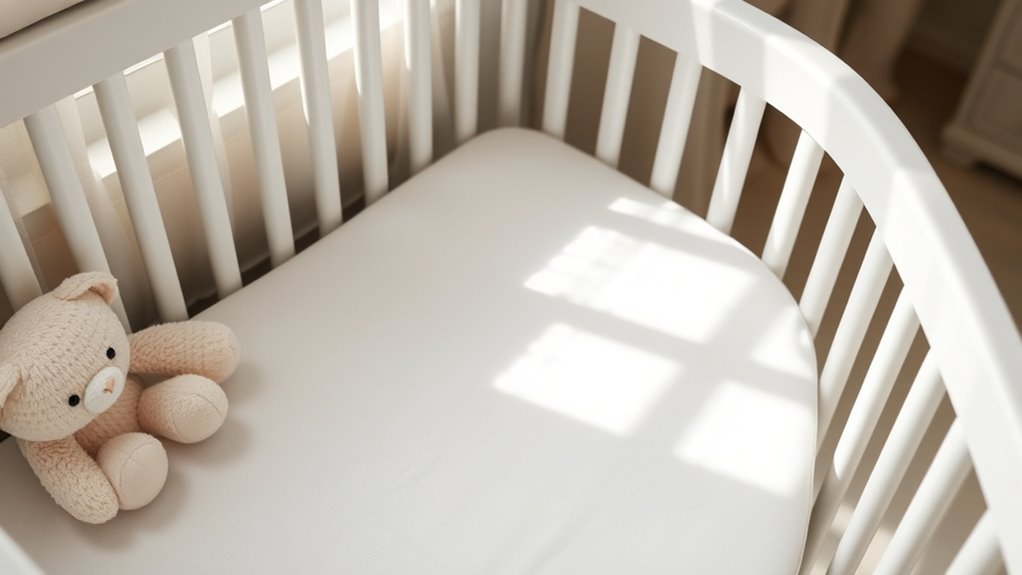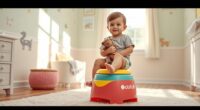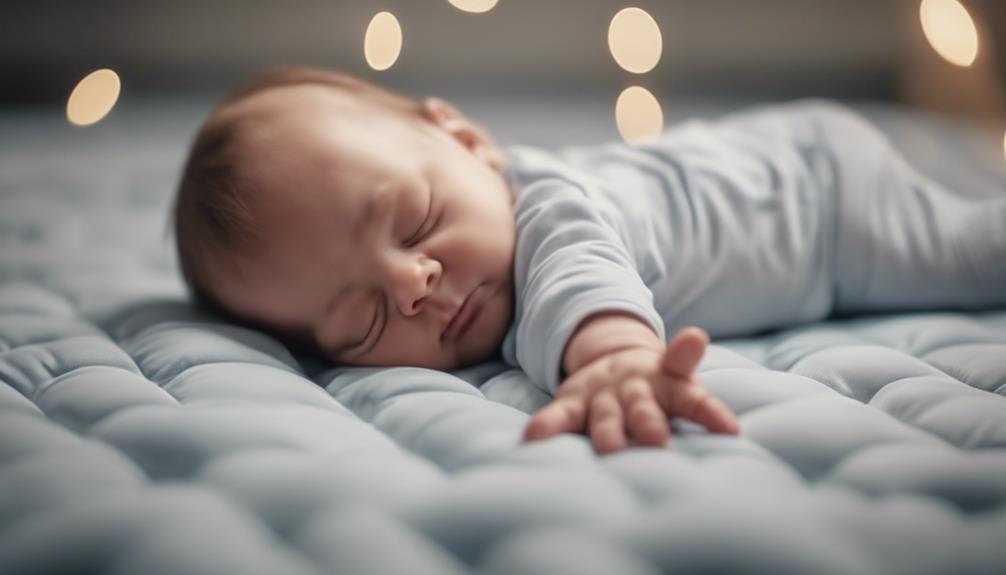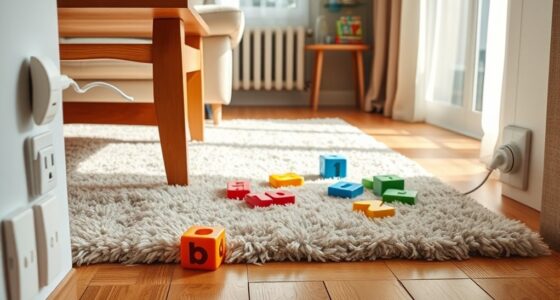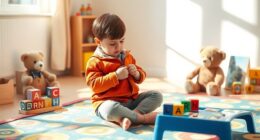To guarantee your newborn’s crib is safe, check that the mattress fits snugly with no gaps and is firm and at the lowest level. Remove loose bedding, pillows, and toys, and avoid soft padding or bumper pads. Make sure the crib’s slats are no more than 2 3/8 inches apart and that the structure is stable and free of sharp edges. Keep hazards like cords and mobiles out of reach. Keep safety in mind as you assess every detail for a secure sleep environment.
Key Takeaways
- Ensure the crib has a firm, snug-fitting mattress with no gaps or soft padding.
- Verify slats are no more than 2 3/8 inches apart and the crib structure is stable.
- Remove loose bedding, pillows, stuffed animals, and bumper pads for a safe sleep environment.
- Position the crib away from windows, cords, and furniture to prevent hazards.
- Perform regular safety checks, stay updated on recalls, and adjust as your baby grows.

Are you confident your baby’s crib is completely safe? It’s natural to want the best for your newborn, but ensuring their sleep environment is secure requires careful attention. Start with baby proofing tips that focus on reducing hazards and creating a safe space. One of the most important aspects is mattress safety, which directly impacts your baby’s comfort and safety during sleep. A firm, well-fitting mattress is essential because it provides proper support and reduces the risk of suffocation or Sudden Infant Death Syndrome (SIDS). Make sure the mattress fits snugly against the sides of the crib without any gaps where your baby could get trapped or become wedged. When shopping for a mattress, look for one that is firm and free of any soft padding or plush materials, which aren’t suitable for infants and may pose suffocation hazards.
Next, check the crib’s slats and bars. They should be no more than 2 3/8 inches apart, ensuring your baby can’t slip their head or body through and get stuck. Avoid using drop-side cribs, as these have been linked to safety concerns, and opt for a sturdy, fixed-side model instead. The mattress should be placed at the lowest level to prevent your baby from climbing or falling out as they grow and become more mobile. When making adjustments, always recheck that the mattress remains secure and flush against the sides. Additionally, contrast ratio plays a role in how well you can see and identify hazards in the crib environment, contributing to overall safety.
When it comes to baby proofing tips, remove any loose bedding, pillows, stuffed animals, or bumper pads from the crib. These items can pose suffocation risks and should be kept out of reach. Use a fitted sheet that’s specifically designed for crib mattresses to ensure a secure fit and avoid loose fabric that could bunch up. Regularly inspect the mattress for signs of wear, stains, or tears, and replace it if it’s no longer firm or shows damage. Clean the mattress with mild soap and water periodically to prevent dust and allergens from accumulating.
Finally, keep the crib free of any hanging cords, mobiles, or toys that could cause strangulation or choking hazards. Positioning the crib away from windows, cords, or furniture also minimizes risk. Staying vigilant about these details ensures your newborn’s sleep environment remains as safe as possible, giving you peace of mind and your baby a secure place to rest. Remember, safety isn’t a one-time task but an ongoing process of monitoring and adjusting to keep your little one protected.
Frequently Asked Questions
Can I Use a Secondhand Crib Safely?
You can use a secondhand crib safely if you carefully assess its condition. Start with a thorough used crib inspection, checking for loose or broken parts, and verify no recalls have been issued. Verify that the crib meets current safety standards and remove any drop-side rails. If you notice any damage, it’s best to avoid using it. Prioritize your baby’s safety by ensuring the secondhand crib is clean, sturdy, and up-to-date on safety regulations.
How Often Should I Replace Crib Bedding?
You should replace your crib bedding regularly to guarantee safety and cleanliness. Experts recommend a monthly replacement schedule, especially for sheets and pillowcases, to prevent mold, dust, and allergens from accumulating. Always inspect your crib bedding for wear and tear, and replace any damaged items immediately. Using fresh, clean bedding keeps your baby comfortable and reduces the risk of allergies or suffocation hazards, making regular replacement essential.
Are Crib Bumpers Safe for Newborns?
Think of crib bumpers as the sirens of childhood—tempting but risky. You should avoid using crib bumpers because they can pose suffocation and entrapment hazards. Soft bedding and other crib accessories might seem cozy, but they heighten the risk of Sudden Infant Death Syndrome (SIDS). Instead, opt for a firm, tightly fitted mattress with a fitted sheet. Keeping the crib simple ensures your newborn’s safety and peace of mind.
What Are the Signs of a Defective Crib?
You should check for signs of a defective crib by inspecting the crib material for splinters, cracks, or loose parts. Look at the structural integrity—if the crib wobbles, has bent or broken slats, or missing hardware, it’s unsafe. Any rust or peeling paint can also be warning signs. Regularly examine your crib to verify it remains sturdy and free from damage, protecting your baby from potential hazards.
Is It Safe to Use a Mattress That’S Not From the Crib Manufacturer?
Using a mattress not from the crib manufacturer can be a risky gamble—like walking a tightrope without a safety net. You should always prioritize mattress compatibility and follow manufacturer recommendations to guarantee your baby’s safety. Non-standard mattresses might not fit properly, creating gaps or uneven surfaces that could be dangerous. To keep your little one safe, stick with the recommended mattress size and brand, and avoid shortcuts that could compromise their safety.
Conclusion
By following this crib safety checklist, you guarantee your newborn’s bed is safe, secure, and snug. Check regularly, tighten everything, and eliminate hazards to create a peaceful sleep space. Keep the mattress firm, the bedding minimal, and the surroundings free of clutter. Prioritize safety over convenience, vigilance over complacency, and comfort over compromise. When you stay attentive, you provide not just a safe sleep environment, but peace of mind, confidence, and love for your little one.

